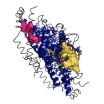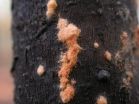(Press-News.org) Using funding provided under the American Reinvestment and Recovery Act, the U.S. Department of Energy's Savannah River National Laboratory has launched a demonstration project near one of the Savannah River Site's former production reactor sites to clean up chemically contaminated groundwater, naturally.
A portion of the subsurface at the Site's P Area has become contaminated with chlorinated volatile organic compounds that are essentially like dry-cleaning fluid. SRNL and Clemson University have patented a consortium of microbes that have an appetite for that kind of material.
"If they are as effective as we expect in cleaning up the chemical contamination in the groundwater, it will be far cheaper than energy-intensive types of cleanup, such as pump-and-treat techniques or soil heating," said Mark Amidon, SRNL's project manager for the demonstration.
The mixture of microbes was found occurring naturally at SRS, where they were feeding on the same kind of chemical that was in groundwater seeping into an SRS creek. SRNL and Clemson University worked together on the discovery and characterization of the microbes. The mixture is called MicroCED, for "microbiological-based chlorinated ethene destruction," and when injected into the subsurface can completely transform lethal chlorinated ethenes to safe, nontoxic end products.
In P Area, the first step was to make groundwater conditions better for the microbes. "In late summer we injected more than 5,000 gallons of emulsified soybean oil, buffering agents and amendments and 108,000 gallons of water to get the dissolved oxygen and acidity right," Amidon said. "Once the conditions were right, we started injecting the store of microbes we've been culturing." An initial application of 18 gallons of the microbes was recently injected to get things started. By the end of the demonstration, approximately 1,500 gallons of the microbes could be injected into the demonstration site.
Amidon estimated that it would take a year or more to see appreciable results. "You can't rush Mother Nature."
The current test site is about 100 by 120 feet at the surface and 85 to 100 feet below ground, and will be used to determine whether this approach should be used for full-scale treatment of the area. "If we were to go full-scale, there would be a 'biowall' about 1,000 feet long and between 50 and 145 feet below ground," Amidon said.
SRNL has been working in bioremediation for many years, using existing microorganisms as part of the strategy. The difference here is the culturing and injection of quantities of a specific mixture of microbes for use on chlorinated solvents. (Another SRNL invention, BioTiger™, is a consortium of microbes used on petroleum contamination.)
INFORMATION:
SRNL is DOE's applied research and development national laboratory located at the Savannah River Site. SRNL puts science to work to support DOE and the nation in the areas of environmental management, national and homeland security, and energy security. The management and operating contractor for SRS and SRNL is Savannah River Nuclear Solutions, LLC.
SRNL demonstrating low-energy remediation with patented microbes
Naturally occurring microbes break down chlorinated solvents
2011-02-01
ELSE PRESS RELEASES FROM THIS DATE:
Communication pathways within proteins may yield new drug targets to stop superbugs
2011-02-01
INDIANAPOLIS – A School of Science at Indiana University-Purdue University Indianapolis biophysicist has developed a new method to identify communication pathways connecting distant regions within proteins.
With this tool, Andrew J. Rader, Ph.D., assistant professor of physics, has identified a mechanism for cooperative behavior within an entire molecule, a finding that suggests that in the future it may be possible to design drugs that target anywhere along the length of a molecule's communication pathway rather than only in a single location as they do today. The discovery ...
Wild rainbow trout critical to health of steelhead populations
2011-02-01
CORVALLIS, Ore. – Genetic research is showing that healthy steelhead runs in Pacific Northwest streams can depend heavily on the productivity of their stay-at-home counterparts, rainbow trout.
Steelhead and rainbow trout look different, grow differently, and one heads off to sea while the other never leaves home. But the life histories and reproductive health of wild trout and steelhead are tightly linked and interdependent, more so than has been appreciated, a new Oregon State University study concludes.
The research could raise new challenges for fishery managers ...
Nanosilver: A new name -- well-known effects
2011-02-01
Numerous nanomaterials are currently at the focus of public attention. In particular silver nanoparticles are being investigated in detail, both by scientists as well as by the regulatory authorities. The assumption behind this interest is that they are dealing with a completely new substance. However, Empa researchers Bernd Nowack and Harald Krug, together with Murray Heights of the company HeiQ have shown in a paper recently published in the journal Environmental Science & Technology that nanosilver is by no means the discovery of the 21st century. Silver particles with ...
Morning after pill linked to increase in STIs, study shows
2011-02-01
Offering the morning after pill free over the counter has not reduced the number of teenage pregnancies and may be associated with a rise in sexually-transmitted diseases (STIs), according to a report by experts at The University of Nottingham.
Professors David Paton and Sourafel Girma used local health authority data to study the impact that the introduction of Government-backed schemes to offer emergency birth control at pharmacies and without prescription have had on conception rates and the diagnosis of STIs among under-18s.
Their findings show that, on average, ...
CERN announces LHC to run in 2012
2011-02-01
Geneva, 31 January 2011. CERN today announced that the LHC will run through to the end of 2012 with a short technical stop at the end of 2011. The beam energy for 2011 will be 3.5 TeV. This decision, taken by CERN management following the annual planning workshop held in Chamonix last week and a report delivered today by the laboratory's machine advisory committee, gives the LHC's experiments a good chance of finding new physics in the next two years, before the LHC goes into a long shutdown to prepare for higher energy running starting 2014.
"If LHC continues to improve ...
Red Bull logo enough to shape consumer performance
2011-02-01
Chestnut Hill, Mass. (1/31/2011) – Red Bull's red and gold logo can "give you wings" – for better or worse – even if consumers don't know it, according to a new study by two Boston College professors, who found the brand's edgy marketing efforts have sold a heavy dose of attitude to consumers.
Researchers put subjects at the controls of a car racing video game, supplying each with functionally identical racecars, but each car decorated with a different brand logo and color scheme.
Players put in control of the Red Bull car displayed the characteristics often attributed ...
Specific populations of gut bacteria linked to fatty liver
2011-02-01
The more we learn about biology, the closer we get to being able to treat disease – and the more complicated our understanding of disease itself becomes.
A new research finding showing a strong relationship between complex microbial ecologies in human intestines and the common but serious medical condition known as fatty liver illustrates this paradox.
From past genomic studies, we have learned that a mind-boggling multitude of different kinds of benign bacteria inhabit our intestines and that these populations can vary almost infinitely from one human being to the ...
Free radicals in cornea may contribute to Fuchs dystrophy, most common cause of corneal transplants
2011-02-01
Boston, MA—Scientists have found that free radicals (unstable molecules that cause the death of cells as the body ages) may also cause the damage in the eyes of patients with Fuchs Endothelial Corneal Dystrophy (FECD), a hereditary disease that is one of the most common reasons for corneal transplants worldwide.
The finding, published in the November 2010 American Journal of Pathology, holds promise for early and preventative treatments for this disease, which impacts nearly four percent of the population over age 60.
"Our discovery is significant, because it gives ...
Analysis of bread mold genomes demos 'reverse-ecology' tool
2011-02-01
Berkeley – In a demonstration of "reverse-ecology," biologists at the University of California, Berkeley, have shown that one can determine an organism's adaptive traits by looking first at its genome and checking for variations across a population.
The study, to be published the week of Jan. 31 in the journal Proceedings of the National Academy of Sciences, offers a powerful new tool in evolutionary genetics research, one that could be used to help monitor the effects of climate change and habitat destruction.
The researchers scanned the genes of 48 different strains ...
Hunt for dark matter closes in at Large Hadron Collider
2011-02-01
The scientists have now carried out the first full run of experiments that smash protons together at almost the speed of light. When these sub-atomic particles collide at the heart of the CMS detector, the resultant energies and densities are similar to those that were present in the first instants of the Universe, immediately after the Big Bang some 13.7 billion years ago. The unique conditions created by these collisions can lead to the production of new particles that would have existed in those early instants and have since disappeared.
The researchers say they are ...
LAST 30 PRESS RELEASES:
Researchers uncover axonal protein synthesis defect in ALS
Why are men more likely to develop multiple myeloma than women?
Smartphone-based interventions show promise for reducing alcohol and cannabis use: New research
How do health care professionals determine eligibility for MAiD?
Microplastics detected in rural woodland
JULAC and Taylor & Francis sign open access agreement to boost the impact of Hong Kong research
Protecting older male athletes’ heart health
KAIST proposes AI-driven strategy to solve long-standing mystery of gene function
Eye for trouble: Automated counting for chromosome issues under the microscope
The vast majority of US rivers lack any protections from human activities, new research finds
Ultrasound-responsive in situ antigen "nanocatchers" open a new paradigm for personalized tumor immunotherapy
Environmental “superbugs” in our rivers and soils: new one health review warns of growing antimicrobial resistance crisis
Triple threat in greenhouse farming: how heavy metals, microplastics, and antibiotic resistance genes unite to challenge sustainable food production
Earthworms turn manure into a powerful tool against antibiotic resistance
AI turns water into an early warning network for hidden biological pollutants
Hidden hotspots on “green” plastics: biodegradable and conventional plastics shape very different antibiotic resistance risks in river microbiomes
Engineered biochar enzyme system clears toxic phenolic acids and restores pepper seed germination in continuous cropping soils
Retail therapy fail? Online shopping linked to stress, says study
How well-meaning allies can increase stress for marginalized people
Commercially viable biomanufacturing: designer yeast turns sugar into lucrative chemical 3-HP
Control valve discovered in gut’s plumbing system
George Mason University leads phase 2 clinical trial for pill to help maintain weight loss after GLP-1s
Hop to it: research from Shedd Aquarium tracks conch movement to set new conservation guidance
Weight loss drugs and bariatric surgery improve the body’s fat ‘balance:’ study
The Age of Fishes began with mass death
TB harnesses part of immune defense system to cause infection
Important new source of oxidation in the atmosphere found
A tug-of-war explains a decades-old question about how bacteria swim
Strengthened immune defense against cancer
Engineering the development of the pancreas
[Press-News.org] SRNL demonstrating low-energy remediation with patented microbesNaturally occurring microbes break down chlorinated solvents



